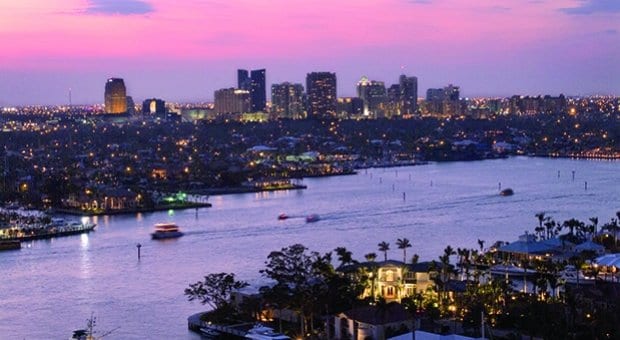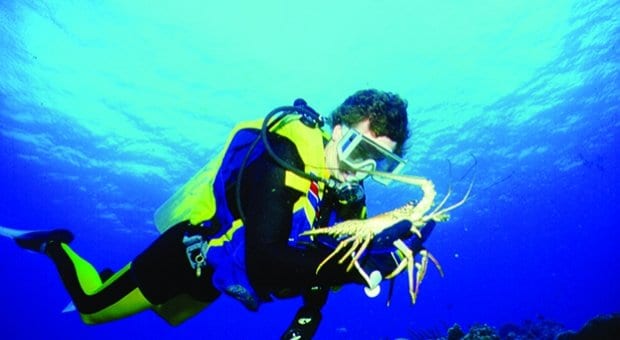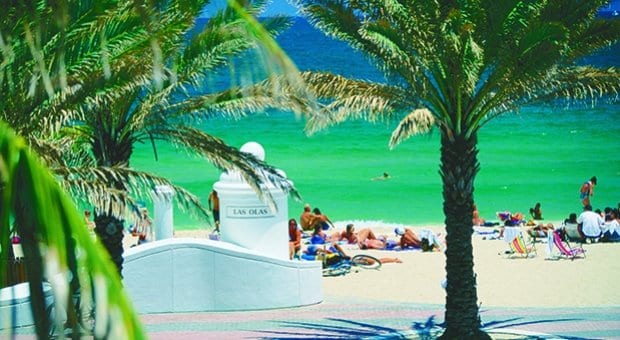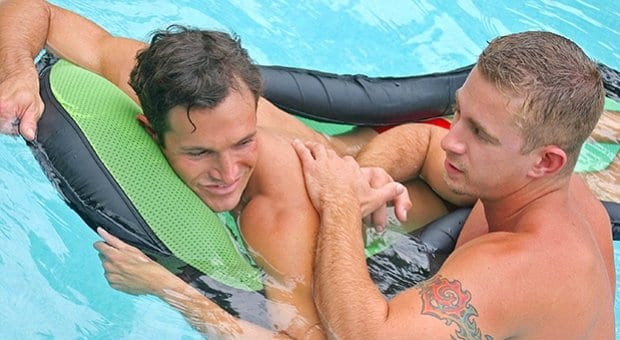
Fort Lauderdale at night. Credit: Visit Florida

Scuba diving off the coast near Fort Lauderdale. Credit: VISIT FLORIDA

A leisurely walk along the shops and boutiques on Las Olas ends at an award-winning beach. Credit: VISIT FLORIDA
It’s unlikely that any other film title has so accurately — yet unwittingly — foreshadowed a destination’s destiny as Where the Boys Are. The 1960 coming-of-age Connie Francis trifle about four Midwestern gals looking for love on the beaches of Fort Lauderdale added fire to the spring-break industry that blossomed in the city post–World War II. On the surface the scene was all hetero boys angling for babes, but by the mid-’70s, a titular twist was in motion.
Back then, the gay playground of choice was the Marlin Beach Hotel, an oceanfront cruising ground that hosted tea dances and disco icons like Sylvester and Pamala Stanley. A lower-deck bar had windows into the swimming pool, a precursor to the modern-day W Fort Lauderdale’s glass-walled staircase that passes through its rooftop pool.
The Marlin’s life cycle paralleled the rise and fall of Fort Liquordale’s most hedonistic spring-break years: after sliding from belle of the beach into seediness, it was bulldozed in the ’90s along with numerous straight party haunts to make way for luxury hotels.
Regardless of its reinvention from winter party headquarters to a more upmarket destination, the Greater Fort Lauderdale area’s subtropical appeal hasn’t changed — particularly for cold-weary northerners. (More than 800,000 Canadians visited in 2010.) Twenty-three miles of beaches hug the coastline, 300 miles of inland waterways are packed with yachts, and a multi-tiered scuba and snorkelling paradise of live coral, wrecks and artificial reefs sits just offshore.
When the college kids retreated to beer-soaked cities further up Florida’s coast, gay men jumped on the gentrification bandwagon. In 1991 the high-end Royal Palms opened two blocks from Fort Lauderdale Beach, helping to drive a gay guesthouse boom that would grow to 20-plus mostly clothing-optional accommodation options.
Where the Marlin once stood is now the cheesy Beach Place shopping plaza (Hooters, anyone?), but the gay crowd still congregates on the sands just to the north at Sebastian St, with weekends particularly packed. A monthly tea dance launched this year at the Royal Palms, which incorporated two new buildings during its 2011 renovation and ventured beyond the aging guesthouse formula to a tropical-minimalist boutique hotel.
There are now more than 150 gay-owned businesses in the city, with the inland enclave of Wilton Manors serving as the official gaybourhood and site of June’s Stonewall St Festival and Parade. Within a few blocks’ stretch of Wilton Dr you’ll find a gay sports bar, a bear hangout, a long-running lesbian bar, a sprawling nightlife complex and, the venerable granddaddy of them all, Georgie’s Alibi, which packs ’em in for its gasoline-grade, dirt-cheap Long Island iced teas on Thursday nights. There’s even a quirky gift shop that sells every popular candy manufactured in the US since 1806 alongside Betty Boop collectibles and gay greeting cards.
Think of Fort Lauderdale as the laid-back resort counterpoint to the urban swagger of its rival to the south, Miami: it’s less pretentious, less body-conscious, skews older — and is more overtly gay.
With the beach and all the rainbow accoutrements, it’s easy for queer visitors to become myopic. But there is more to Fort Lauderdale outside the strip-mall sprawl. The trick is to get back to nature. South Florida was a virtual wilderness until the early 1900s, and remnants of this swampy history still hover around its developments — should the locals pack up en masse, it’s not hard to imagine a jungle of vegetation reclaiming the entire area in a matter of weeks. Take to the area paddling trails or jump in an airboat to experience this unspoiled beauty, home to herons, manatees, alligators and endangered Florida panthers.
Getting around
Fort Lauderdale–Hollywood International Airport is located three miles southwest of downtown Fort Lauderdale. Broward County Transit’s #1 bus shuttles passengers between the airport and downtown. A taxi to Fort Lauderdale costs roughly $12 (all prices US), $25 to $30 to Wilton Manors.
Getting there
Broward County Transit offers an expansive bus system that covers most of the region. A one-way fare costs $1.75; an all-day pass is $4. The Tri-Rail commuter train stops at Fort Lauderdale–Hollywood International Airport and downtown Fort Lauderdale. A round-trip from Fort Lauderdale to Miami, for example, costs just $5 on weekends.
For map locations and website links to more than 150 area places of interest see our gay Fort Lauderdale listings pages.

 Why you can trust Xtra
Why you can trust Xtra